#judaculla rock
Text
Petroglyph at Judaculla Rock
Petroglyph at Judaculla Rock
On our recent day trip to see all of the beauty of fall in western North Carolina and beyond, Chris and I stopped at Judaculla Rock again. I blogged about our visit there years ago but of course for some reason I can not find that post anymore to link to it. That’s okay. I took a few more pictures on this visit and it really is a wonderful spot to stop if you are in the area.
One thing that we…

View On WordPress
0 notes
Text
Join us for a journey through time with the world's oldest art form—rock paintings and engravings! This mysterious Rock Art across Millennia reveals the rich tapestry of rock paintings, in the captivating depictions of human-animal hybrids, vibrant animals, and intricate patterns that tell the tales of our ancient ancestors.
From the cup and ring marks found in Scotland to the enigmatic Judaculla rock full of petroglyphs in North Carolina, U.S, the elegance, mystery, and daily lives of ancient civilizations are unveiled in these awe-inspiring depictions.
#rock art#cave art#paintings#petroglyphs#engravings#cup and ring marks#ancient#history#ancient origins
13 notes
·
View notes
Text
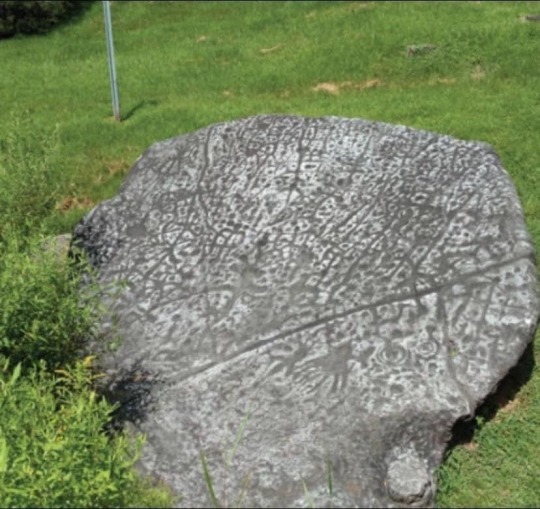
The Mystery Behind This Ancient Marvel In North Carolina Will Baffle You: Buried in the mountains of Jackson County just outside of Sylva, there exists a very, very strange rock. The rock is rather large and adorned with mysterious and indistinguishable carvings and writings. The ancient petroglyphs are said to date back almost 3000 years. The story of the rock and how it came to be is unknown, but deeply rooted in Cherokee folklore.
Judaculla Rock has no definitive origin and is said to date back to before the Cherokee Indians inhabited the land. The drawings, carvings, writings all seem to be some sort of 'map' or maybe a story? Archaeologists believe the rock might be 2,000-3,0000 years old.
The name Judaculla derives from the Cherokee word Tsul`kälû´which is the name of a giant who was said to inhabit the area prior to the Cherokee Indians. Tsul`kälû´translates to 'he has them slanting.' The slanting referring to his eyes. Tsul`kälû´(or Judaculla) was said to be 7ft. tall, with 14 fingers and toes. Of course, as the man of the land, Tsul`kälû´is tightly linked with the legend of the rock.
Cherokee folklore states the carvings are imprints of his feet, as he would jump from rock to rock. Another source claims Tsul`kälû´carved the rock as a hunting guide, with rules for others to follow. As the largest in the area, he controlled all of the game.
Another strange fact about Judaculla Rock is that several similar carvings are now being discovered in the area and along the southeastern mountain region.
If you link this with another nearby legend - the strange statues and Cherokee stories of the 'moon-eyed people,' then it seems things really get strange.
Between the moon-eyed, nocturnal, cave-dwelling 'people' who supposedly left several strange structures and the sheer evidence of Judaculla Rock...there's a lot of mystery and folklore to this section of the state.
The rock has gained much notoriety during its known time of existence. The Cherokee saw it as a sacred place, and believed it pre-dated their presence. The rock has been the site of 'initiation' and ritual ceremonies from both Western Carolina Students and nearby travelers and locals. With a small graveyard tucked not far away, strange, ghostly occurrences have been reported in the area.
Throughout the years, the rock has experienced much change due to weathering. It's best to visit it as soon as possible. While visible and still readable, no one (even world-renowned researchers) have been able to solve or figure out the origin and meaning behind North Carolina's most mysterious rock.
Judaculla Rock is a soapstone boulder situated at the base of a mountain and believed to be one of three similar rocks found at the site (while one was reportedly buried during a 20th century mining operation). It’s free to view the rock and is best to view it ASAP because, as mentioned above, it is quickly eroding.
Everyone has their own theory on this rock – and those who witness it firsthand feel and understand the presence and mystery of this strange object. What do you think is the true story and origin of Judaculla Rock? Have you been here before?
(From Only In Your State)
#appalachian#appalachian mountains#north carolina#appalachian culture#appalachia#western north carolina#the south#nc mountains#appalachian folklore
15 notes
·
View notes
Photo

Here is my video of our visit to Judaculla Rock near Cullowhee, NC in August of 2021. A little tough to find. No sign once off the main road. A beautiful site. The carved images are much more viewable with the naked eye.
#cullowhee #cullowheenc #judaculla #judacullarock #judacullarocknc #northcarolina
https://youtu.be/6R1OfvyCrgU
0 notes
Quote
The Judaculla Rock in North Carolina is one of the greatest mysteries in North America. The 230-square-foot soapstone boulder is covered with more than fifteen hundred ancient carvings and petroglyphs.



47 notes
·
View notes
Note
It's been such a week that I forgot it was Friday, honestly. It was my first week back to school and some other stressful things happened. Do you have a happy or more lighthearted fun fact to share this evening?
...uh.
[looks at notes]
Hm. Not really? But I've got this rock?

Judaculla Rock is in North Carolina, a rock with a bunch of weird images carved into it. It apparently had ceremonial significance to the Cherokee people of the region. It's named after Judaculla, a figure from Cherokee legend (a giant, I think?) who was a hunter sort who in some versions of the story carved the rock himself. There are scholars who think it predates Cherokee presence in the area though.
And there are some think it's some kind of map? Take a looksie:
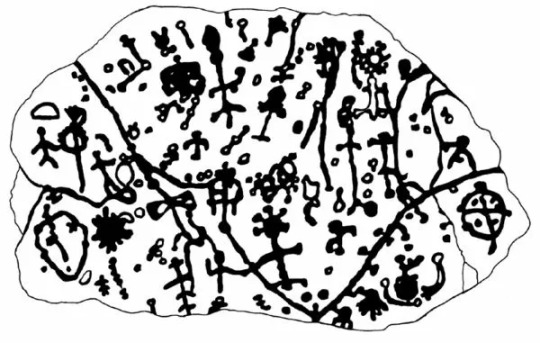
So yeah, some Appalachian history for you. The North Carolina history museum in Raleigh has a replica.
32 notes
·
View notes
Link
On March 27, 2013, Judaculla Rock, a soapstone boulder in Jackson County, was added to the National Register of Historic Places.
[top: Milas Parker sits behind Judaculla Rock. Parker once owned the property on which the rock sits; image from the State Archives. bottom: A wider view of Judaculla Rock, circa 1935-40; image from the State Archives.]
Though commonly identified simply as a boulder covered with ancient and mysterious engravings, Judaculla Rock is the best-known and largest example of an American Indian petroglyph that can be found in North Carolina.
The petroglyphs, or rock art, at Judaculla were carved intermittently within the Late Woodland to Late Mississippian periods from about 500 A.D. to 1700. The rock itself is actually one of several petroglyph boulders within a 15-acre area that is an archaeological site of great significance.
The site is also a landscape component of a prominent Cherokee legend that chronicles the vast supernatural and physical realm of a creature known as Judaculla. Cullohwee, six miles from the rock, is believed to be a shortened and anglicized form of Judaculla-whee, meaning “Judaculla’s Place.”
Today, the Judaculla Rock is managed by Jackson County, which received the property in 1959 as a donation from the Parker family, very conscientious caretakers who still own the surrounding lands. The Eastern Band of the Cherokee is a principal partner in efforts to protect, enhance, and celebrate the site.
This Day in NC History: Judaculla Rock Named National Historic Place
#NC#history#Judaculla Rock#Petroglyphs#Cherokee#National Register of Historic Place#NC History#This Day in NC History
1 note
·
View note
Text
Rock Your World With These Puzzly Mysteries!
In today's blog post, we explore some mysterious inscriptions, including a French rock that might've finally been solved!

[Image courtesy of Atlas Obscura.]
We’ve spent a lot of time over the last few months discussing treasure hunts, but those are far from the only puzzly adventures that can send solvers out into nature. If you prefer your puzzling to have a codebreaking or cryptographic angle, we’ve got you covered there as well.
There are three mysterious stones in the United States alone that bear mysterious…
View On WordPress
#atlas obscura#basque#brittany#codebreaking#codecracking#codecraft#cryptography#decalogue stone#decipher#decryption#dighton rock#DIY puzzling#France#judaculla rock#New Mexico#new mexico mystery stone#north carolina#old breton#plougastel-daoulas#puzzle mystery#puzzle rock#PuzzleNation#Puzzlin&039; fool#puzzly mystery#the connexion#translation#united states
0 notes
Text
dude, North Carolina just has ghosts and weird structures in it. There's two locations I know of where things roll uphill but there might be a third.(Mystery Hill, Gravity Hill.)
Also some other cool locations. The Devil's Tramping Grounds, house of mugs, Cloud Chamber of Trees and Sky, Shangri-La stone town, Judaculla's Rock, Moon Eyes Structure, Brown Mountain, Acid Park, just to name of few. Oh and I guess we've got NASCAR too.
I've only ever been to Mystery Hill but maybe with the lack of people I could convince my family to go on a road trip this winter break and visit some places. If not I'll settle for driving around and looking at the abandoned barns and textile mills lol.
Seriously though, search up some of these places. They're wild. bbbbbbbbbbbb
1 note
·
View note
Photo
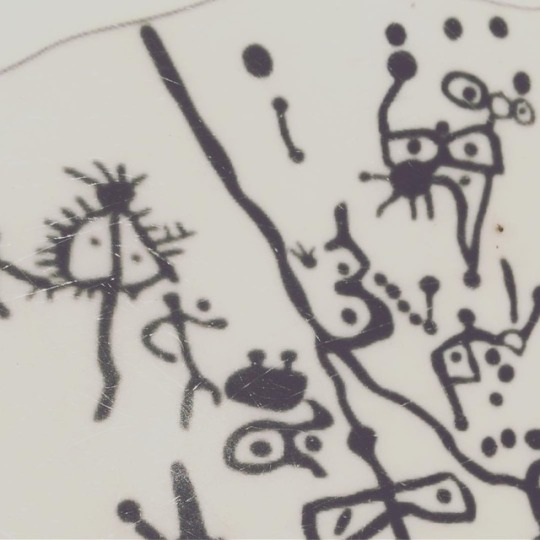
So that guy that looks all normal, tossing a ball in the air? That's me. 😂 #petroglyph #rock #petroglyphs #stone #judaculla #life #love #judacullarock #wisdom #cherokee #culture #archaeology #people
#judacullarock#petroglyphs#culture#archaeology#stone#wisdom#cherokee#petroglyph#judaculla#life#love#rock#people
1 note
·
View note
Text
In 2013 Judaculla Rock, located in Cullowhee, North Carolina approximately ten minutes from Western Carolina University, was put on the National Register of Historic Places. Although, it is just a rock it holds more than just being a nature display for the public. If you are a person who is interested of Native Americans history, enjoy simple sightings, or just simply love to learn new facts than this a good little stop to visit while you are up in the Western North Carolina region.
Judaculla Rock is 30 miles from the Qualla boundary, home to the Eastern Band of Cherokee Native Americans today. In fact, Cullowhee used to be a historic Cherokee town as well as the site of a council house mound. The rock, according to Cherokee legend, was believed to have served as a boundary for hunting grounds and was guarded by the slant eye monster Judaculla.
It was said that Judaculla lived on Balsam Mountain and he guarded his hunting grounds from the Devil’s Courthouse (a site that is access nearby the Blue Ridge Parkway) in which was his judgement seat. One day a group of hunters intruded Judaculla’s land and this was disrespecting the giant. Angry, he chased them away and landed near Caney Fork Road. While trying to balance himself using a nearby large boulder he left traces of his palm on the rock. If you looked closely at the rock, you can start to make out some line traces like that of a palm.
There are also other markings and drawings on the rock made by the Cherokees, this is known as Petroglyph and began around 1500 years ago until the Cherokee’s life and tradition were broken by European settlement. These markings or drawings may have symbolized notable events or created during rituals.
The Parker family, for 100 years, have been guarding the rock for generations to keep it away from vandalism. And it is one of the America’s most important historical places since it is an important ancestral place to the Cherokee.
And though there may not be much of a view to see, do enjoy the short beautiful view once you turned onto Caney Fork Road. Plus, you can make a quick stop at East LaPorte Park where there a beautiful lake for you to enjoy, relax, and take a quick swim.
Extra Pictures:
Travel Diaries: Judaculla Rock In 2013 Judaculla Rock, located in Cullowhee, North Carolina approximately ten minutes from Western Carolina University, was put on the National Register of Historic Places.
#born to explore#explore more#girls love to explore#Judaculla Rock#travel#Travel Diaries#travel more#traveling#Western Carolina
1 note
·
View note
Photo
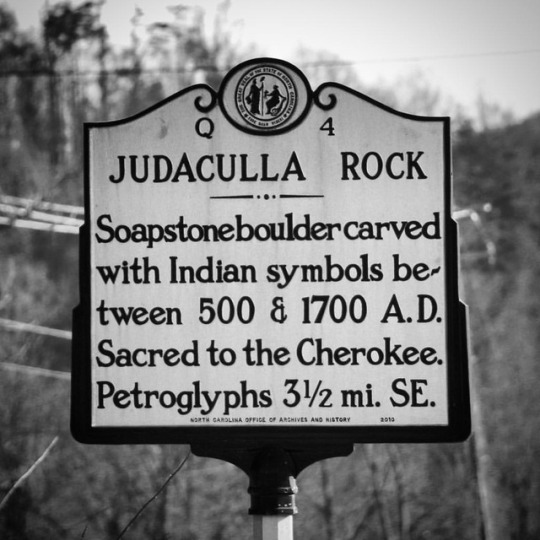
#VisitNC -Judaculla Rock is a curvilinear-shaped outcrop of soapstone with quarry scars and #petroglyphs. With over 1,000 man-made impressions, it is considered the most densely covered #petroglyph rock east of the Mississippi. Judaculla retains a special significance to the #Cherokee. Legends state the rock serves as a boundary marker between the tribe and the giant, whereas other theories claim the boulder is a map to the underworld, or a map displaying various #portals that Judaculla could travel to. Judaculla the #giant was driven away from the lands by various Cherokee banding together to claim the territory as their land....But where did all these giants of #ancient lore go? And why are some of these petroglyphs so familiar to ones we’ve discovered in the Southwest? #TeamCanon #exploring #forgotten #history in #blackandwhite with the #CanonEOS T7i, EF-S 55-250mm STM lens. (at Judaculla Rock) https://www.instagram.com/p/BtojlGNn0rD/?utm_source=ig_tumblr_share&igshid=11hgkfnebtjji
#visitnc#petroglyphs#petroglyph#cherokee#portals#giant#ancient#teamcanon#exploring#forgotten#history#blackandwhite#canoneos
6 notes
·
View notes
Photo
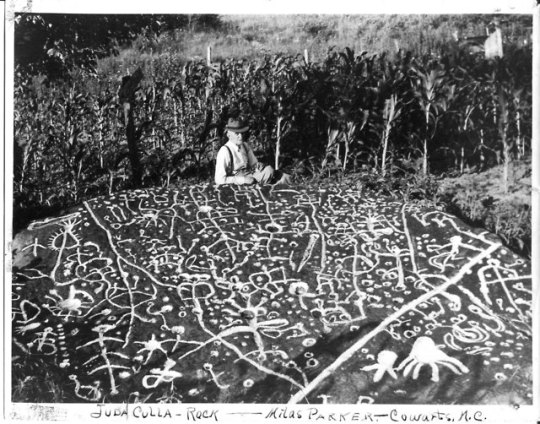
Judaculla Rock is North Carolina’s best known and largest example of an American Indian petroglyphs site dating from 12,000 B.C. to 400 A.D. In the modern and generic sense, it is a public attraction and a point of interest, and is commonly identified as a boulder covered with ancient and mysterious engravings, but it is much more. Judaculla Rock is one of several petroglyph boulders within a 15 acre area that is an archaeological site of great significance. Broader still, the Judaculla Rock site is but one landscape component of a prominent Cherokee legend that chronicles the vast supernatural and physical realm of Judaculla.
To get a fuller concept of this notable relic of Cherokee times, some statement about the greater mythical character, Judaculla himself would be helpful. To begin with, the name, Ju-da-cul-la, is the white man’s corruption of the Cherokee word, Tsul`kälû, the root of which derives from the idea of something slanting, which in this case refers to his eyes, as he was sometimes referred to as the Great Slant-eyed Giant. By all accounts, Judaculla was a human-like giant with supernatural powers, who traveled between This World and the Underworld. On a 1900 map by Mooney, Judaculla Rock is mapped along with principal Cherokee towns and other notable major features, suggesting its relative importance to the Cherokee people. Of his otherworldly powers, Tsul`kälû primarily was considered to be the Master of all Game Animals. In their daily lives, the Cherokee included his name in their formulas, rites, and rituals to ensure success in hunting.
The glyph origin story tells of Tsul`kälû in chase of rogue hunters, and he leapt down from his mountaintop fields and landed in the Caney Fork creek bottom lands (a distance of over 10 miles and 3,200 feet). As he landed he stumbled and put out a hand to keep from falling. His hand pressed against a giant boulder to steady his massive frame. In so doing he left several indentations, including an impression of his hand. Then with the with the nail of his right index finger, he drew a sharp line across the face of the rock that was to remind people that harm would come to those who crossed it without first going through the appropriate rituals. Shining Rock, is yet another place of reverence for the Cherokee, and also the general location for petroglyphs. The Cherokee know Shining Rock area as “Where the tracks are this way.” Here, Tsul`kälû’s children left tracks in the rocks while on their way from Kanuga to their home at Tanasee Bald.
11 notes
·
View notes
Link
News and Reflections: "Judaculla Rock Petroglyphs | Blue Ridge Heritage Trail" https://blueridgeheritagetrail.com/explore-a-trail-of-heritage-treasures/judaculla-rock/ from the Blue Ridge Heritage Trail website (accessed 9/7/2021) Association des Acadiens-Metis Souriquois blog site: https://acadiens-metis-souriquois.ca/aams-blog/news-and-reflections-judaculla-rock-petroglyphs-blue-ridge-heritage-trail-september-7-2021
0 notes
Text
Judaculla Rock
Around Cullowhee, NC, a strange greenish-brown outcrop of soapstone jutting up at an angle has long been called Judaculla Rock. That’s a corruption of Tsul`kälû’, the Cherokee name for “slant-eyed” giant they believed placed it there. The weird markings on it are between 1,000 and 10,000 years old, according to some archaeologists. No one knows what all the peculiar images in its surface mean. Some think it is a history of the local people, some think it records a treaty with the Catawba tribe, and some people think it’s just a giant doodle.
It’s a mystery that not even the Cherokee can solve. In their own legends, the markings were left after Tsul`kälû’ used the rock as a stepping-stone while leaping his mountain home eight miles away down to the Canery Fork creek that runs below here. Since the Cherokee don’t remember what the markings mean, the field is wide open for any other explanation.
One Ashville-based paranormal group has advanced the hypothesis that the rock is evidence of a visitation by ancient astronauts from another planet. These aliens had microscopes thousands of years before that device was invented. To support this notion, the group points to similarities between some of the peculiar shapes visible on the rock and infinitesimal amoebas, hydras, and certain forms of bacteria.
On the other hand, many of the shapes also bear an uncanny resemblance to the 1950s linoleum patterns, but we’re not willing to conclude that this means the rock was carved by a prehistoric Ozzie and Harriet.
We’re more inclined to think Judaculla Rock is covered with some kind of archaic pictograms. The Cherokees are among the first Native Americans to have a written language, after Sequoyah developed the Cherokee syllabary between 1809 and 1823. But maybe a much earlier individual who lived in this valley gave written language a shot a few thousand years before that. If so, he or she would have been a real giant, but in the intellectual sense of the word.
To visit Judaculla Rock, go about four miles south of Cullowhee on Highway 107, and then turn eat for three miles on Caney Fork Road and follow the signs. The road fizzles out in a private driveway, but park just before that and walk downhill.
0 notes
Note
Huh, so the stone/hill that baby Zak destroyed which put him in Tsul`kälû´ s crosshairs might have been Judaculla Rock or something similar?
Huh, cool
0 notes